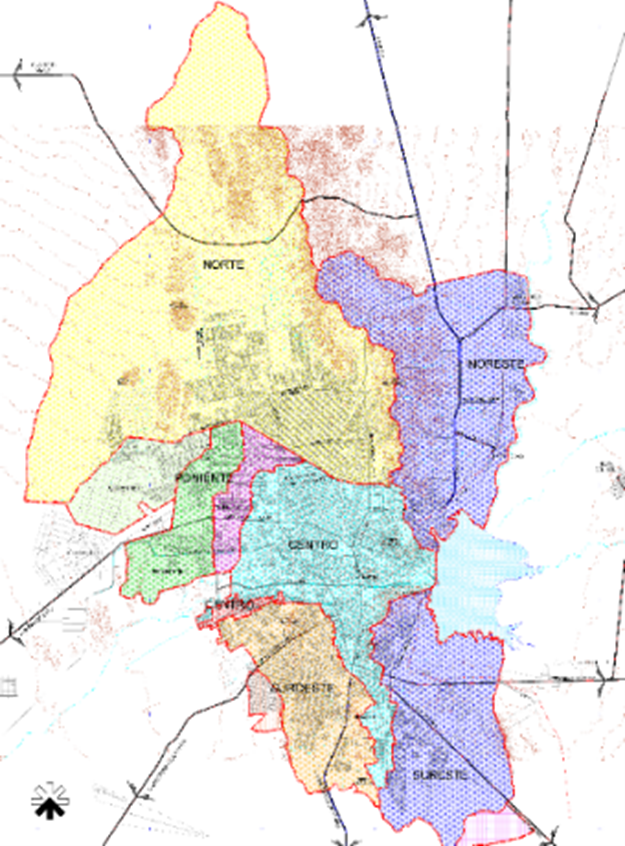Urban Connectivity Analysis in the City of Hermosillo, Sonora.
DOI:
https://doi.org/10.36790/epistemus.v16i33.247Keywords:
Spatial syntax, urban morphology, urban networkAbstract
The present study is of a non-experimental, cross-sectional and descriptive type and aims to explain the relationship between the urban morphology of the city and the road axes that compose it, through a spatial syntax analysis implementing the Depthmax tool. Among the first results, it stands out that the road axes with the greatest connectivity are located in the north, center and southwest of the city; the road axes with greater integration and depth are located to the north; and those of greater choice in the center. Finally, it is concluded that through the spatial syntax it is feasible to analyze the possible openings of green areas; which, thanks to the spatial configuration, the main pattern of mobility of the subjects, allows modifications of pedestrianization in areas of interest.
Downloads
References
M. Martinez, “Configuración espacial de la ciudad de Cartago y su relación con volúmenes vehiculares”, Revista Infraestructura Vial. 2017, vol. 19, No. 34, pags. 18-27.
Depthmapx, Recuperado 18 de Enero, 2015, de http://www.spacesyntax.net/.
F. Holanda, “O espaço de exceção”. Brasília: Editora Universida de Brasília, 2002, pp. 97.
S. Ronchi, "Un indicador de morfología urbana para la planificación del paisaje en Lombardía (Italia)", Gestión de la Calidad Ambiental. 2018, vol. 29, No. 4, págs. 623-642. https://doi.org/10.1108/MEQ-05-2017-0048 DOI: https://doi.org/10.1108/MEQ-05-2017-0048
J. Uribe, “Hermosillo Siglo XX”. 2ª ed. Publicaciones la Diligencia, 2018.
INEGI. (2020). Panorama sociodemográfico de Sonora 2020. Recuperado el 30 de noviembre de 2021, de http://cuentame.inegi.org.mx/monografias/informacion/son/poblacion/
B. Hillier, “A theory of the city as object: or, how spatial laws mediate the social construction
of urban space”. Urban Design International, 2002.
S. Geng, "Análisis comparativo de entornos hospitalarios en Australia y China
utilizando el enfoque de sintaxis espacial", Revista internacional de patología y adaptación de
la construcción. 2021, vol. 39, No. 3, pp. 525-546. https://doi.org/10.1108/IJBPA-04-2020-
Lagarda, I., Noriega, J., & Vázquez, M. (2009). Hermosillo a traves de los mapas. Hermosillo, Sonora: El autentico S.A. de C.V.
IMPLAN, Recuperado 30 de Julio, 2018, de http://implanhermosillo.gob.mx/metro/pdf/D1_CUENCAS.pdf.
A. Turner, “UCL Depthmap 7: From Isovist Analysis to Generic Spatial Network Analysis”. New Developments in Space Syntax Software, ITU Faculty of Architecture, Istanbul 2007.
A. van Nes, “Introduction to Space Syntax in Urban Studies”, Springer, 2021, pp. 5-265. DOI: https://doi.org/10.1007/978-3-030-59140-3
Y.S. Hegazi, "Reimaginar el núcleo histórico de Rosetta a través de la
sintaxis espacial", Archnet-IJAR. 2019, vol. 13, No. 3, pp. 645-669.
https://doi.org/10.1108/ARCH-05-2019-0109
A.M. Navastara, “Application of space syntax method to measure spatial
connectivity in campus of Institut Teknologi Sepuluh Nopember (ITS)”, IOP Conf. Series: Earth
and Environmental Science, 2018, num. 202, doi: https://doi.org/10.1088/1755-1315/202/1/012015 DOI: https://doi.org/10.1088/1755-1315/202/1/012015
M.O. Sanni-Anibire, M.A. Hassanain, A.S. Mahmoud, W. Ahmed, "An evaluation of the functional performance of research and academic laboratories using the space syntax approach", International Journal of Building Pathology and Adaptation, 2018, Vol. 36 No. 5, pp. 516-528. https://doi.org/10.1108/IJBPA-04-2018-0028 DOI: https://doi.org/10.1108/IJBPA-04-2018-0028
HMH. Thai, "Mapeo y medición de la conectividad espacial de los caminos hacia los negocios
en el hogar dentro de contextos urbanos informales", Archnet-IJAR. 2022, vol. 16, No. 1, pp.
-111. https://doi.org/10.1108/ARCH-02-2021-0034 DOI: https://doi.org/10.1108/ARCH-02-2021-0034
B. Hillier, “Normalización de la opción de ángulo mínimo en Depthmap y cómo abre nuevas
perspectivas en el análisis global y local del espacio de la ciudad”. The Journal of Space
Syntax, 2012, Vol. 3, pp. 155-160.
S. Geng, "Análisis comparativo de entornos hospitalarios en Australia y China
utilizando el enfoque de sintaxis espacial", Revista internacional de patología y adaptación de
la construcción. 2021, vol. 39, No. 3, pp. 525-546. https://doi.org/10.1108/IJBPA-04-2020-0031. DOI: https://doi.org/10.1108/IJBPA-04-2020-0031
Depthmapx, Recuperado 18 de Enero, 2015, de http://www.spacesyntax.net/.
F. Lazo, “City’s imaginary / imaginary for the city. The paradigm of the commercial image in
the tourist city. Barcelona Case”. Universidad Politenica de Catalunya, 2012, pp. 1-19.
K. Ravari, "The development of residential spatial configuration for visual privacy in Iranian dwellings, a space syntax approach". International Journal of Building Pathology and Adaptation, 2022, https://doi.org/10.1108/IJBPA-05-2021-0080. DOI: https://doi.org/10.1108/IJBPA-05-2021-0080
Y.S. Hegazi, “Re-imaging Rosetta historic core through Space Syntax”, 2019, Archnet-IJAR, DOI: https://doi.org/10.1108/ARCH-05-2019-0109
Vol. 13 No. 3, pp. 645-669.
A. Arslan, “Small House Spatiality: A Comparative Space Syntax Application”, Open House International, 2017, Vol. 42 No. 2, pp. 58-67. https://doi.org/10.1108/OHI-02-2017-B0009. DOI: https://doi.org/10.1108/OHI-02-2017-B0009
S. Lida, “Network and Psychological Effects in Urban Movement”, In A.G. Cohn & A.D. Mark
(eds), COSIT 2005, LNCS 3693, 2005, pp. 475-490.
F. Lamiquiz, “Implicaciones de la accesibilidad configuracional en la movilidad peatonal. El
caso de Madrid”. Departamento de Urbanismo y Ordenación del Territorio Escuela Técnica
Superior de Arquitectura de Madrid, 2011, pp. 5-410.

Downloads
Published
How to Cite
Issue
Section
License
Copyright (c) 2023 EPISTEMUS

This work is licensed under a Creative Commons Attribution-NonCommercial-ShareAlike 4.0 International License.
The magazine acquires the patrimonial rights of the articles only for diffusion without any purpose of profit, without diminishing the own rights of authorship.
The authors are the legitimate owners of the intellectual property rights of their respective articles, and in such quality, by sending their texts they express their desire to collaborate with the Epistemus Magazine, published biannually by the University of Sonora.
Therefore, freely, voluntarily and free of charge, once accepted the article for publication, they give their rights to the University of Sonora for the University of Sonora to edit, publish, distribute and make available through intranets, Internet or CD said work, without any limitation of form or time, as long as it is non-profit and with the express obligation to respect and mention the credit that corresponds to the authors in any use that is made of it.
It is understood that this authorization is not an assignment or transmission of any of your economic rights in favor of the said institution. The University of Sonora guarantees the right to reproduce the contribution by any means in which you are the author, subject to the credit being granted corresponding to the original publication of the contribution in Epistemus.
Unless otherwise indicated, all the contents of the electronic edition are distributed under a license for use and Creative Commons — Attribution-NonCommercial-ShareAlike 4.0 International — (CC BY-NC-SA 4.0) You can consult here the informative version and the legal text of the license. This circumstance must be expressly stated in this way when necessary.
The names and email addresses entered in this journal will be used exclusively for the purposes established in it and will not be provided to third parties or for their use for other purposes.























